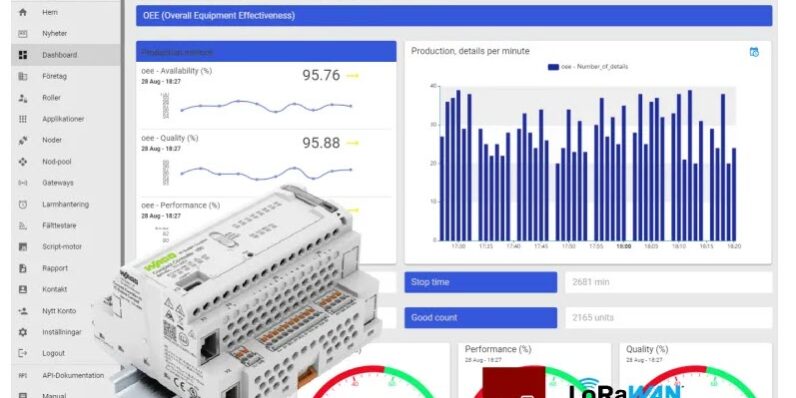The Internet of Things (IoT) has been rapidly evolving and transforming the way industries and businesses operate. With the advent of Industry 4.0, also known as the Fourth Industrial Revolution, IoT has become even more critical for the efficient functioning of various industries. In this era of connected devices, the use of sensors plays a significant role in collecting data and transmitting it to the cloud for analysis and decision-making. One such sensor technology that has gained popularity in recent times is the LoRaWAN sensor.
What is LoRaWAN?
LoRaWAN (Long Range Wide Area Network) is a low-power wide-area network (LPWAN) protocol that enables long-range communications between IoT devices. It operates in the unlicensed frequency spectrum and provides a cost-effective and scalable solution for IoT devices that require low data rates, long battery life, and secure communications.
Advantages of Using LoRaWAN Sensors in IIoT 4.0
The following are the key benefits of using LoRaWAN sensors in Industry 4.0:
1. Cost-Effective Solution
One of the primary advantages of using LoRaWAN sensors is their cost-effectiveness. They are less expensive compared to traditional wireless communication technologies, making them a suitable option for small and medium-sized enterprises (SMEs). The low-power consumption of LoRaWAN sensors also reduces the cost of energy, making them a cost-effective solution for long-term usage.
2. Long-Range Communications
Another benefit of LoRaWAN sensors is their ability to transmit data over long distances. This makes them an ideal solution for remote and rural areas where other communication technologies may not be available. With LoRaWAN, data can be transmitted over distances of up to 15 km in rural areas and up to 5 km in urban areas.
3. Scalable Solution
LoRaWAN sensors are also a scalable solution for IoT devices.

4. Improved Overall Equipment Efficiency (OEE)
One of the significant advantages of using LoRaWAN sensors in Industry 4.0 is their ability to improve the overall equipment efficiency (OEE) of a production process. The sensors can collect real-time data about the production process, enabling companies to monitor and optimize their operations. With this data, companies can identify bottlenecks, reduce downtime, and improve their overall production efficiency, leading to increased OEE.
Moreover, the ability to remotely monitor and control equipment also leads to reduced maintenance costs, as maintenance can be performed proactively before equipment failure occurs. This results in reduced downtime and improved equipment reliability, further increasing OEE.
Why OEE is important ?
Production industries rely on three core factors: machine utilization, the quality of produced goods, and machine/operator performance. These three elements combined are represented by the overall equipment efficiency (OEE) metric, which measures how efficiently a production process is running. A higher OEE score results in a greater number of shippable products and lower production costs, making it a crucial metric for both short and long-term success.
An OEE score of 85% is considered exceptional, but many manufacturing facilities fall below this standard, with an average score of around 40%. This presents an opportunity for continuous improvement and increased productivity through the use of the OEE metric. By monitoring and analyzing OEE scores on a daily, monthly, and yearly basis, facilities can identify areas for improvement and work towards reducing waste.
ransform and visualize your company’s productivity with Sensor-Online, a flexible and scalable IOT platform. Our solution makes it simple and affordable to monitor and enhance your OEE (Overall Equipment Effectiveness) in manufacturing processes. With the option to add wired and/or wireless sensors, you can gather real-time data for a comprehensive overview of your production.
Machine Runtime Monitoring: Gain full visibility into machine runtime in any factory setting with our solution. Monitor uptime, downtime, pulse counts, and machine efficiency per shift, and identify any issues quickly to save time and money on repairs.
Key Features:
- Monitor Production KPIs
- Connect and collect data from any machine
- Generate reports
- Trigger alarms
- Log machine downtime and take preventive action
OEE tracking is essential for efficient production management and supervision. Keeping a close eye on OEE allows production managers to make necessary changes and optimize production to minimize losses. OEE tracking is not just about showcasing the performance of a production process at different stages and times, but about identifying areas for improvement. Take action on suggestions for increased productivity.
Learn more about how you can improve productivity with our machine runtime monitoring solutions by contacting us at +46 500 6000 22 or via email. Check out our range of wireless sensor technology, services, and software at https://nodeledge.se/Nodeledge.pdf.
Conclusion
In conclusion, the use of LoRaWAN sensors in Industry 4.0 offers numerous benefits, including cost-effectiveness, long-range communications, scalability, and improved overall equipment efficiency (OEE). With the ability to collect real-time data, companies can make informed decisions and optimize their operations, leading to increased efficiency and competitiveness.






